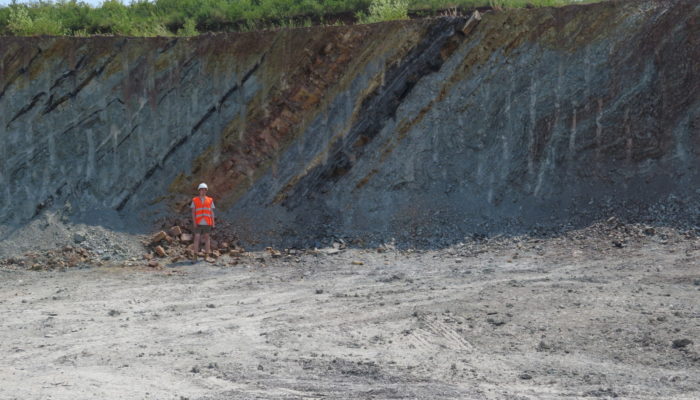
This is a solicited blogpost written by Lawrence Percival, who will also present his work on the Oceanic Anoxic Event 2 as part of session SSP2.1 of the upcoming EGU GA.
The increasing concern regarding 21st climate change and environmental disturbance has led to a renewed focus on similar episodes of global crisis through Earth’s history. During the Late Devonian Period, 380–360 million years ago, a series of such environmental disturbances took place. These changes were characterized by times of abrupt global temperature changes and widespread oxygen-depletion throughout the world’s oceans, ultimately resulting in one of the five greatest mass extinction events of animal life (of which the death of the dinosaurs 66 million years ago is the most famous, with suggestions that modern-day climate change will cause a 6th mass extinction).
However, whilst the dinosaur mass extinction has been widely suggested as having been caused by the collision of a 10-km wide meteorite with planet Earth, the cause of the Late Devonian climate/environmental changes remains far less clear. The top four ideas that have been blamed for this event include: meteorite impacts, massive volcanism, and elevated runoff of nutrients to the ocean during increased weathering of rocks in mountainous areas and by expansion of the world’s first forests.
Particularly intriguing is the idea of excess nutrients as a major driver of lowering the oxygen content of the world’s oceans. This phenomenon is being directly observed in the modern world, with the runoff of fertilizer leading to algal and plankton blooms that rapidly use up oxygen in the water when they die and are broken down by bacteria. Additionally, the weathering of rocks that could have led to excess nutrient runoff during the Late Devonian would also have used up carbon dioxide from the atmosphere and caused global climate changes.

Simplified phosphorus cycle in coastal marine environments. The feedback of increased phosphorus content causing increased biological productivity causing anoxia causing recycling of organic phosphorus from sediments is illustrated (drawn by L. Percival).
In a recent study at the University of Lausanne in Switzerland, my colleagues and I investigated the cycling of phosphorus during the Late Devonian climate/environmental crises [1]. By studying sedimentary rocks that were deposited in seas at a number of sites around the world (Germany, Poland, France, Morocco, and Australia), we found that several of the Late Devonian events began with an abrupt increase in the amount of phosphorus in widespread parts of the global ocean. Even more interestingly, there was clear evidence once seawater oxygen levels fell, phosphorus was efficiently recycled from sediments back into the seawater.
Therefore, the increased runoff of nutrients such as phosphorus into the world’s oceans likely caused a positive feedback of environmental degradation during the Late Devonian events, with the initial input of phosphorus from land causing algal and plankton blooming in that area. In turn, this productivity increase resulted in the loss of oxygen from the seawater they inhabited, which allowed for recycling of phosphorus from the seafloor sediments, which sustained the blooming organisms and oxygen depletion. Such a cascade of environmental disturbances linked to perturbations in nutrient cycling has also been reported for other times in Earth’s history [2,3,4]. These findings highlight the importance of managing the runoff of nutrients (from fertilisers and other sources) into the modern-day oceans.
References:
[1] Percival, L.M.E., Bond, D.P.G., Rakociński, M., Marynowski, L., Hood, A., Adatte, T., Spangenberg, J.E. and Föllmi, K.B., 2020, Phosphorus-cycle disturbances during the Late Devonian anoxic events. Global and Planetary Change, 184, https://doi.org/10.1016/j.gloplacha.2019.103070
[2] Murphy, A.E., Sageman, B.B. and Hollander, D.J., 2000, Eutrophication by decoupling of the marine biogeochemical cycles of C, N, and P: A mechanism for the Late Devonian mass extinction. Geology, 28, p. 427–430, https://doi.org/10.1130/0091-7613(2000)28<427:EBDOTM>2.0.CO;2
[3] Mort, H.P., Adatte, T., Föllmi, K.B., Keller, G., Steinmann, P., Matera, V., Berner, Z. and Stüben, D., 2007, Phosphorus and the roles of productivity and nutrient recycling during oceanic anoxic event 2. Geology, 35, p. 483–486, https://doi.org/10.1130/G23475A.1
[4] Kraal, P., Slomp, C.P., Forster, A. and Kuypers, M.M., 2010, Phosphorus cycling from the margin to abyssal depths in the proto-Atlantic during oceanic anoxic event 2. Palaeogeography, Palaeoclimatology, Palaeoecology, 295, p. 42–54, https://doi.org/10.1016/j.palaeo.2010.05.014
Author:
Lawrence Percival obtained his PhD from the University of Oxford, spent his first postdoc at the University of Lausanne, and is currently based at the Vrije Universiteit Brussel. His research combines sedimentology and geochemical analyses to unravel processes that drove climate change and mass extinction in our planet’s past.
